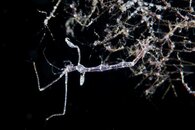I shoot Nikon. But Canon and Nikon both make excellent macro lenses. I think both have a 60 mm macro and a 105 mm macro. Being macro lenses means at minimum focus the size of the image on the sensor of your camera is life size which makes for a pretty "close up" image. Both lenses are 2.8 F which is pretty good. Now the 60, requires a shorter distance needed for a close up and tends to have a greater depth of field. The 60 is probably best for low visibility. I don't know what you mean by "low visibility". Obviously, if the visibility is really low, nothing will work. But a visibility of 30' say, should be fine.
There are advantages to the 105. It has greater reach. You have to get pretty close with the 60. Some tube worms will contract if you get close enough for a good close up with a 60. The 105 would also seem to be good for taking shots of those pesky small fish that move quickly and will not let you get close. The bad part of the 105 is it is harder to focus and has a narrow depth of field.
Also because of the close focus, there is no way that you can do super macro photography with the 60. You can do this with diopters and a 105 that allows you to magnify really small critters like little blennies to create dramatic results.
In your case, I would suggest the 60 mm lens.




